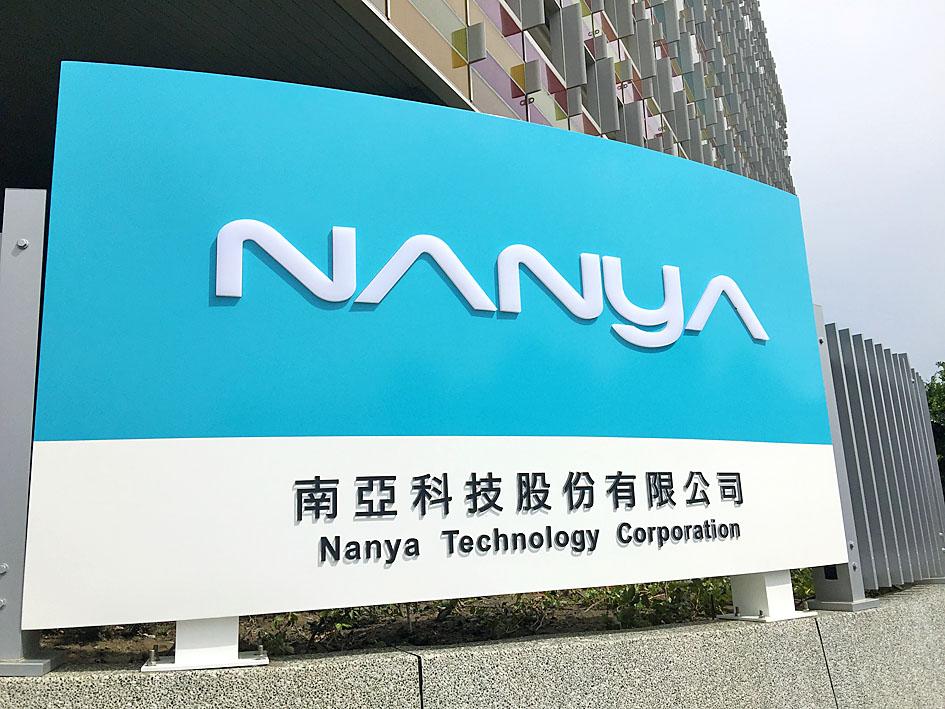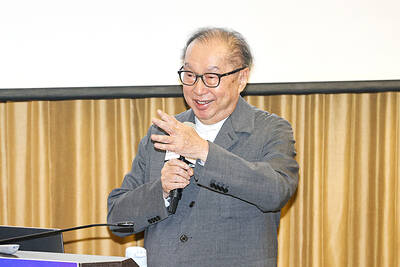Nanya Technology Corp (南亞科技) yesterday said that the memorychip industry is heading into a moderate correction period through early next year after a booming third quarter, during which its net profits almost quadrupled from a year earlier.
The nation’s biggest DRAM chipmaker expects the latest downturn would be short-term on the back of a slim inventory of chip supplies and relatively robust demand from servers, commercial computers and high-end consumer electronics such as smart speakers and networking devices.
However, an uneven supply of key components could cut into their growth, the chipmaker said.

Photo: Hung Yu-fang, Taipei Times
“This is not the winter for DRAM [companies],” Nanya Technology president Lee Pei-ing (李培瑛) told a virtual media briefing.
“The industry is entering a correction period in the fourth quarter and will be in place in the first quarter next year, but it will not last long and will not be as dramatic as it was in 2017, or 2018,” Lee said.
For Nanya Technology, revenue this quarter might slowly return to the level between the third quarter and second quarter, Lee said.
That was a downgrade from an estimate of flat or mild growth three months ago, he said.
The chipmaker expects prices to drop sequentially this quarter, while shipments remain little changed.
Nanya Technology yesterday scaled back its capital expenditure budget for this year to NT$12 billion (US$427.87 million) from an earlier estimate of NT$15.6 billion, due to a delay in equipment payments.
During the previous downcycle, most memorychip makers managed to make a small profit during the chilly seasons, which was different from the industry slump five or 10 years ago that pushed almost all memorychip suppliers into a crisis, Lee said.
It is a different situation this time, as most DRAM suppliers have seen their inventory fall to an extremely low level, or have leveled off all inventory, Nanya Technology said.
By application, Chromebooks showed some weakness as a rush by consumers approaches its end, it said.
Demand for automotive and industrial devices is also declining amid a scarcity of chips, mostly made with 8-inch wafers including power management ICs, driver ICs and audio ICs, Nanya Technology said.
A surprise halt in electronics production at factories in Malaysia, Vietnam and other Southeast Asian countries due to COVID-19 restrictions further curtailed memorychip demand, it said.
Nanya Technology saw net profit soar last quarter to NT$7.53 billion, compared with NT$1.61 billion in the third quarter last year. That represented quarterly growth of 22 percent from NT$6.16 billion.
Earnings per share jumped to NT$2.44 last quarter, from NT$0.53 a year earlier and NT$2 in the prior quarter.
A 20 percent price hike helped boost gross margin to 49.2 percent last quarter from 42.3 percent in the second quarter. Gross margin stood at 25.9 percent one year earlier.
Commenting on the US’ latest efforts to boost chip supply chain transparency, Nanya Technology said it would not release customers’ confidential information.

BYPASSING CHINA TARIFFS: In the first five months of this year, Foxconn sent US$4.4bn of iPhones to the US from India, compared with US$3.7bn in the whole of last year Nearly all the iPhones exported by Foxconn Technology Group (富士康科技集團) from India went to the US between March and last month, customs data showed, far above last year’s average of 50 percent and a clear sign of Apple Inc’s efforts to bypass high US tariffs imposed on China. The numbers, being reported by Reuters for the first time, show that Apple has realigned its India exports to almost exclusively serve the US market, when previously the devices were more widely distributed to nations including the Netherlands and the Czech Republic. During March to last month, Foxconn, known as Hon Hai Precision Industry

Taiwan Semiconductor Manufacturing Co (TSMC, 台積電) and the University of Tokyo (UTokyo) yesterday announced the launch of the TSMC-UTokyo Lab to promote advanced semiconductor research, education and talent development. The lab is TSMC’s first laboratory collaboration with a university outside Taiwan, the company said in a statement. The lab would leverage “the extensive knowledge, experience, and creativity” of both institutions, the company said. It is located in the Asano Section of UTokyo’s Hongo, Tokyo, campus and would be managed by UTokyo faculty, guided by directors from UTokyo and TSMC, the company said. TSMC began working with UTokyo in 2019, resulting in 21 research projects,

Ashton Hall’s morning routine involves dunking his head in iced Saratoga Spring Water. For the company that sells the bottled water — Hall’s brand of choice for drinking, brushing his teeth and submerging himself — that is fantastic news. “We’re so thankful to this incredible fitness influencer called Ashton Hall,” Saratoga owner Primo Brands Corp’s CEO Robbert Rietbroek said on an earnings call after Hall’s morning routine video went viral. “He really helped put our brand on the map.” Primo Brands, which was not affiliated with Hall when he made his video, is among the increasing number of companies benefiting from influencer

Quanta Computer Inc (廣達) chairman Barry Lam (林百里) yesterday expressed a downbeat view about the prospects of humanoid robots, given high manufacturing costs and a lack of target customers. Despite rising demand and high expectations for humanoid robots, high research-and-development costs and uncertain profitability remain major concerns, Lam told reporters following the company’s annual shareholders’ meeting in Taoyuan. “Since it seems a bit unworthy to use such high-cost robots to do household chores, I believe robots designed for specific purposes would be more valuable and present a better business opportunity,” Lam said Instead of investing in humanoid robots, Quanta has opted to invest